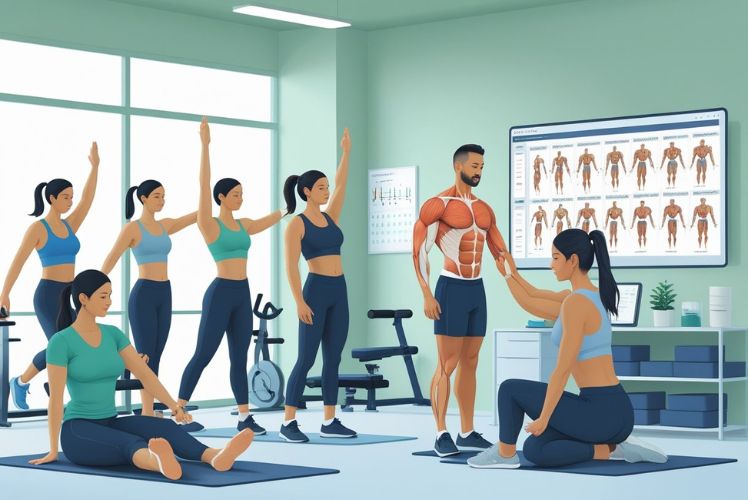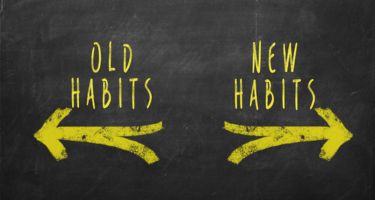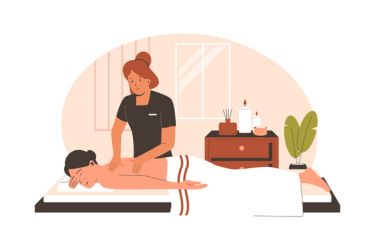Kinesiology is the scientific study of human movement, exploring how our bodies move, function, and respond to different stimuli. By understanding kinesiology, we gain valuable insights into the mechanics of the body, ways to improve health, prevent injuries, and support physical performance. This field brings together anatomy, physiology, biomechanics, and even holistic approaches to health.

As we look further, we will discover how kinesiology not only guides fitness and rehabilitation, but also opens up numerous academic and career pathways. Whether we are athletes, students, or anyone curious about how the body works, learning about kinesiology can help us make informed decisions for a healthier and more active lifestyle.
Key Takeaways
- Kinesiology studies how our bodies move and function.
- It has practical uses in health, sports, and rehabilitation.
- Career and learning opportunities in kinesiology are growing.
Fundamentals of Kinesiology

Kinesiology helps us understand how the human body moves and what influences that movement. It combines elements from anatomy, psychology, and biomechanics, creating a broad picture of how we function in everyday life and physical activity.
Defining Human Movement
Human movement is the study of how our bodies create motion using muscles, bones, and joints. Kinesiology examines actions such as walking, running, lifting, and throwing by looking at how these body parts work together.
We focus on both gross motor skills (like hopping or jumping) and fine motor skills (such as writing). These movements depend on signals sent from our nervous system to our muscles. Factors like balance, coordination, and flexibility also play major roles.
By studying movement, we learn how to improve posture, prevent injuries, and enhance performance. Kinesiology gives us tools to analyse everyday actions and sporting skills, helping us understand what makes some movements more efficient than others.
Core Principles and Concepts
Kinesiology blends knowledge from several fields. The core principles include:
- Anatomy: Understanding bones, muscles, and joints
- Biomechanics: Studying the physical forces and motion
- Physiology: Observing how body systems support movement
- Psychology: Exploring how our minds influence the way we move
We use these concepts to figure out why people move the way they do. For example, muscle strength and joint flexibility affect our range of movement. Motivation and confidence, which come from psychology, often influence how well we perform.
Anatomy charts, diagrams, and practical demonstrations help us visualise these ideas. Applying them lets us design exercise routines, develop safer work habits, and support people in rehabilitation.
Historical Development
Kinesiology has roots in ancient Greece, where philosophers studied body movement and exercise. The science expanded in the 19th and 20th centuries as knowledge of anatomy and physiology advanced.
Physical education became popular in schools, and scientists began to analyse motion using motion capture and slow-motion cameras. This helped us learn more about how athletes performed and why injuries happened.
Over time, the field grew to include areas like psychology, rehabilitation, and sports medicine. Today, kinesiology is a respected discipline taught at universities and used in many careers, such as physiotherapy, teaching, coaching, and athletic training.
Key Areas of Study in Kinesiology

In kinesiology, we focus on how the human body moves, how it responds to exercise, and how the brain controls movement. Understanding these topics helps us improve physical performance and prevent injuries.
Biomechanics of Movement
Biomechanics explores the mechanical principles behind human movement. We analyse how muscles, bones, and joints work together to produce motion. By studying force, balance, and movement patterns, we can identify the most efficient ways for the body to perform physical tasks.
We use tools like motion capture systems and force plates to measure body movements during sports, walking, or daily activities. This helps us understand joint angles, muscle strength, and how different forces act on the body.
Biomechanics is important for designing safer exercise routines and improving athletic technique. It also helps us create better equipment and rehabilitation plans for injuries.
Exercise Physiology Fundamentals
Exercise physiology examines how the body responds and adapts to physical activity. We focus on heart rate, breathing, energy use, and muscle function during exercise.
Understanding how muscles get stronger or more efficient is central to this field. We look at how blood flow changes during activity and how energy is produced in muscle cells. These processes help us improve endurance, muscle strength, and recover from workouts.
Exercise physiology plays a big role in health and fitness. It helps us design training plans, manage chronic conditions, and support rehabilitation after injuries or surgery.
Motor Control and Learning
Motor control and learning involve how our brains and nervous systems control movement. We study how people develop and adjust their movements through practice and feedback.
This area looks at the signals sent from the brain to the muscles, and how we improve skills like walking, running, or playing a sport. We analyse how memory and practice help us perfect movements and develop new motor skills.
By understanding motor learning, we can create more effective coaching, teaching, and rehabilitation methods. This is especially important when helping patients recover after injuries or neurological disorders.
Applications of Kinesiology in Health and Fitness

Kinesiology offers practical benefits by improving how we move, recover, and care for our bodies. It guides us in building fitness, aids injured people returning to daily life, and connects movement with healthy eating.
Physical Activity and Exercise Programmes
We use kinesiology to design safe and effective exercise routines for people at all fitness levels. By understanding muscle function and joint mechanics, we can create tailored programmes that match individual needs—whether for athletes or those new to exercise.
Kinesis-based assessments let us identify movement patterns, strengths, and weaknesses. This knowledge helps in targeting specific goals, such as improving cardiovascular health, increasing strength, or managing weight. For people with disabilities or health conditions, exercise programmes can be adapted to support mobility and independence.
Key benefits include:
- Injury prevention by teaching correct technique
- Progressive overload to build strength gradually
- Confidence in daily activities through movement education
Rehabilitation and Recovery
Recovering from injury or surgery requires careful attention to how the body moves. We apply kinesiology to support the healing process by focusing on biomechanics, motor control, and gradual progression of exercises.
Rehabilitation programmes are customised for each person. We often use tools like range-of-motion tests, resistance training, and balance exercises. By tracking progress, we know when to increase intensity or change activities safely.
Kinesiologists also work with physiotherapists and healthcare teams. Together, we help patients regain function, avoid re-injury, and return to normal activities. For example, after a knee surgery, targeted movements rebuild muscle and restore walking ability step by step.
Nutrition and Wellness
Physical movement is closely linked to what we eat and how we feel. We consider good nutrition as part of a complete approach to health and fitness. Nutritional guidance supports energy for exercise, muscle repair, and overall wellness.
We look at hydration, carbohydrate intake for endurance, and protein for muscle recovery. By evaluating both exercise routines and diet habits, we offer strategies that boost training results and sustain healthy living.
In summary:
- Balanced meals fuel workouts and aid recovery
- Nutrients play a key role in muscle repair
- Collaboration with nutritionists can optimise health outcomes
Career Pathways and Professional Roles

Career options in kinesiology include becoming a kinesiologist, coaching, working in rehabilitation, and contributing in school or university settings. Many roles focus on improving health, supporting recovery, or leading teams in both education and fitness.
Becoming a Kinesiologist
As kinesiologists, we use our expertise in human movement to help people achieve better health and improved physical function. Our work might involve assessing movement patterns, developing exercise plans, and educating clients about body mechanics.
To become a kinesiologist, most of us earn a bachelor's degree in kinesiology or a related field. Some roles require certification or registration, depending on our local regulations. Employers often look for strong practical skills and a deep understanding of human anatomy.
Typical duties include performing fitness assessments, analysing posture and gait, and tracking progress over time. We often work one-on-one with clients or run group workshops. Many of us find positions in private clinics, community centres, or wellness organisations.
Sports Coaching and Leadership
Sports coaching is a popular path for those of us with a kinesiology background. We might coach teams in schools, colleges, or universities, focusing on skill development, teamwork, and injury prevention.
Our training allows us to design effective practice routines and build personalised fitness programmes for athletes. We teach strategy, promote fair play, and encourage positive attitudes towards sport and exercise. Safety is a key concern, so we monitor for injuries and teach proper techniques.
In leadership roles, we may become athletic directors or coordinators, managing entire sports programmes and mentoring new coaches. Our scientific understanding of performance gives us a strong edge in competitive and recreational settings.
Opportunities in Rehabilitation and Therapy
Many of us work in rehabilitation, helping clients recover from injury or illness. As kinesiologists, we collaborate with physiotherapists, occupational therapists, and other health professionals to support recovery.
Our main focus is creating exercise plans that restore mobility, strength, and flexibility. We adapt programmes to suit various conditions, including sports injuries, long-term illness, or surgery recovery. Communication skills are essential as we often teach clients how to exercise safely at home.
We may be employed in hospitals, private physiotherapy clinics, or rehabilitation centres. Our contribution helps patients improve their quality of life and regain functional independence.
Work Environments for Professionals
Our work settings are diverse. We find employment in schools, colleges, and universities, delivering physical education lessons and running wellness programmes. Some of us work in fitness centres, sports clubs, or private clinics.
A few of us choose research or academic roles, helping to advance kinesiology as a field. We may teach university courses, contribute to scientific studies, or assist in designing health initiatives for communities.
Typical workplaces include:
| Setting | Example Roles |
|---|---|
| Schools & Colleges | PE teacher, coach |
| Universities | Lecturer, researcher |
| Sports Clubs & Fitness | Trainer, fitness coordinator |
| Healthcare Facilities | Rehabilitation assistant, therapist |
No matter where we work, our goal is to support movement, health, and wellbeing for all ages.
Education and Academic Pathways
In kinesiology, our education choices shape the careers we can pursue. We must consider the different degree options, what it takes to gain admission, and how to customise our studies to match our interests.
Kinesiology Degree Programmes
We can study kinesiology at colleges and universities at several levels: associate, bachelor’s, master’s, and doctorate degrees. Many UK and international institutions offer these programmes, each focusing on the science of human movement and its applications.
Bachelor’s degrees usually take three to four years and cover the basics of anatomy, physiology, biomechanics, and exercise science. Master’s programmes and doctorates allow us to focus more on research or advanced practice. Some universities may also offer part-time or flexible online learning options.
A typical curriculum involves lectures, laboratory work, and practical placements. We may also be required to complete projects or dissertations, especially for advanced degrees. Choosing the right school often depends on our career plans and whether we’re interested in clinical work, teaching, or research.
Admission Requirements and GRE
Admission requirements for kinesiology degrees vary by school and degree level. For undergraduate courses, we generally need A-levels or equivalent qualifications, often in science subjects such as biology or physical education.
For postgraduate programmes, most universities expect us to hold a relevant bachelor’s degree with a certain grade point average. Some institutions, especially those outside the UK, may require the Graduate Record Examinations (GRE), especially for US-based universities. We might also be asked for references, personal statements, or proof of work experience.
Many schools value hands-on experience, so prior volunteering, coaching, or fitness instruction can strengthen our application. Interview processes may also apply, especially for competitive programmes or clinical tracks.
Specialisations and Research
Kinesiology offers a wide range of specialisations. We can focus on exercise physiology, sports psychology, biomechanics, physical therapy, or motor control. Some programmes let us pick elective modules in areas like health promotion, rehabilitation, or sports management.
Research is encouraged, especially at the master’s and doctorate levels. We may join ongoing studies or design our own projects, working alongside faculty experts. Research topics can range from injury prevention and rehabilitation to population health and the effects of physical activity on chronic diseases.
By following a specialisation, we build expertise in a chosen field. This helps us to tailor our degree towards a specific career path, such as sports coaching, medical research, teaching, or occupational therapy.
Emerging Trends and Future Directions
Kinesiology is seeing rapid changes driven by new research and technology. Our focus is turning towards understanding both the body and mind, while using tools that make health data more accessible.
Stress Management and Mental Health
Stress is a major factor affecting our physical and mental well-being. In kinesiology, we now pay closer attention to how exercise and movement support mental health and help control stress levels.
Research shows that regular physical activity can reduce symptoms of anxiety and depression. Simple exercises, such as brisk walking or yoga, can help us cope better with daily stress. Many programmes now offer mindfulness and breathing exercises alongside traditional workouts.
Kinesiologists are creating routines tailored for stress relief. These routines might include stretching, relaxation exercises, or group activities. We find that social support and structured movement sessions make it easier to manage stress. Understanding this link helps us improve both performance and quality of life.
Technological Advancements in Kinesiology
Technology is changing how we study and apply kinesiology. Wearable devices, fitness trackers, and mobile apps now let us measure movement, heart rate, and even sleep with great accuracy.
We use these tools to track progress, set goals, and adjust training plans in real time. Data collected from these devices helps us spot patterns, monitor recovery, and prevent injuries. For example, some apps can alert us if our movement needs correction or if we need more rest.
Virtual reality and online platforms have also made exercise programmes more interactive and accessible. We can train or join guided sessions from home, making it easier to stay active. As technology improves, we expect personal health monitoring to become a normal part of daily exercise routines.
Frequently Asked Questions
Kinesiology links closely with patient care, rehabilitation, injury prevention, and fitness. As we address common queries, we focus on training, qualification needs, professional pay, special tools, types within the field, and possible risks.
What are the primary applications of kinesiology in healthcare?
We use kinesiology to help prevent and treat injuries, especially muscle and joint issues. It is also applied in managing chronic illnesses like arthritis and diabetes through tailored exercise programmes. Kinesiologists provide rehabilitation after surgery or accidents and offer education on healthy movement patterns.
Does one require a medical degree to practice as a kinesiologist?
A medical degree is not required to become a kinesiologist. Instead, we need a relevant university degree in kinesiology or a related field such as exercise science or physical education. Professional certification or registration may also be needed, depending on our country or region.
What might one expect in terms of remuneration for a professional kinesiologist?
The pay for kinesiologists can vary widely based on location, experience, and type of employment. In the UK, starting salaries for kinesiologists or similar exercise professionals are usually in the range of £18,000 to £25,000 per year. With experience or working in private practice, this can increase.
How is kinesiology tape utilised and what are its benefits?
We use kinesiology tape to help stabilise muscles and joints without restricting movement. It is often applied to support injured areas, reduce swelling, and improve circulation. The tape can also provide sensory feedback, which may help with better posture or movement.
Are there any risks associated with the practice of kinesiology?
For most people, kinesiology is safe. Minor side effects can sometimes occur, such as minor muscle soreness after a session or mild skin irritation from tape. It is important for us to assess each individual's health before starting treatment to avoid potential issues.
What distinguishes applied kinesiology from general kinesiology?
General kinesiology covers the science of how the human body moves, including anatomy, biomechanics, and physiology. Applied kinesiology is a specific practice that uses muscle testing to assess health and make treatment decisions. We should note that some medical organisations consider applied kinesiology to lack strong scientific support, unlike general kinesiology, which is well established.





















